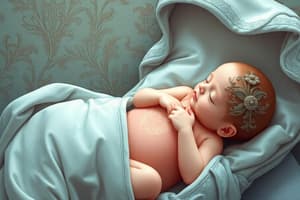Podcast
Questions and Answers
What is the primary cause of an omphalocele?
What is the primary cause of an omphalocele?
Failure of closure of the ventral abdominal wall
What organs can be herniated in an omphalocele?
What organs can be herniated in an omphalocele?
Bowel, liver, spleen, and gallbladder
What is the abnormal characteristic of the umbilical cord in an omphalocele?
What is the abnormal characteristic of the umbilical cord in an omphalocele?
Abnormal insertion into the upper region of the herniated sac
What tissue covers the herniated organs in an omphalocele?
What tissue covers the herniated organs in an omphalocele?
What is the term for the protrusion of organs through the abdominal wall in an omphalocele?
What is the term for the protrusion of organs through the abdominal wall in an omphalocele?
What is the key distinguishing feature between an umbilical cord hernia and an omphalocele in terms of the umbilical cord insertion?
What is the key distinguishing feature between an umbilical cord hernia and an omphalocele in terms of the umbilical cord insertion?
What is the significance of an abnormal karyotype in fetuses with an omphalocele?
What is the significance of an abnormal karyotype in fetuses with an omphalocele?
What is the approximate percentage of fetuses with an omphalocele that have other major anomalies?
What is the approximate percentage of fetuses with an omphalocele that have other major anomalies?
What is the characteristic of the umbilical ring in an omphalocele?
What is the characteristic of the umbilical ring in an omphalocele?
What is the general prognosis for fetuses with an omphalocele?
What is the general prognosis for fetuses with an omphalocele?
Flashcards are hidden until you start studying
Study Notes
Omphalocele
- A large umbilical defect caused by the failure of closure of the ventral abdominal wall
- Characterized by the herniation of organs, including:
- Bowel
- Liver
- Spleen
- Gallbladder
- Herniated organs are covered only by the fetal amniotic membrane
- Abnormal insertion of the umbilical cord into the upper region of the herniated sac
Umbilical Cord Hernias vs Omphaloceles
- Both conditions share similar sonographic features.
- In an umbilical cord hernia, the intestine protrudes only into the base of the hernia.
Distinction between Umbilical Cord Hernia and Omphalocele
- Inspect the umbilical cord insertion to distinguish between the two conditions.
- Umbilical cord hernia: normal insertion of the cord into the umbilical ring with intact skin covering the ring.
- Omphalocele: large defect of the umbilical ring region involving the muscles and the skin.
Characteristics of Omphalocele
- Defect of the umbilical ring is covered with amniotic membranes.
- May contain bowel, liver, and other abdominal viscera.
- Poor prognosis: 30% to 40% of fetuses have an abnormal karyotype.
- 50% to 70% of fetuses have other major anomalies.
Studying That Suits You
Use AI to generate personalized quizzes and flashcards to suit your learning preferences.




